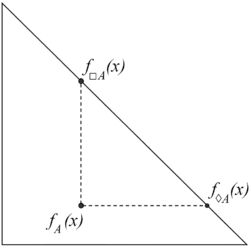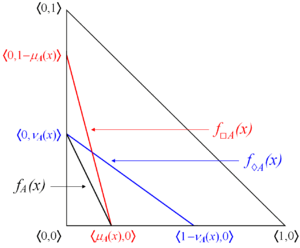Please check our Instructions to Authors and send your manuscripts to nifs.journal@gmail.com.
Necessity and possibility: Difference between revisions
m + image |
mNo edit summary |
||
| Line 2: | Line 2: | ||
'''Necessity and possibility''' in the context of [[intuitionistic fuzzy sets]] are two modal [[Operators over intuitionistic fuzzy sets|operators]] defined as follows: | '''Necessity and possibility''' in the context of [[intuitionistic fuzzy sets]] are two modal [[Operators over intuitionistic fuzzy sets|operators]] defined as follows: | ||
Let <math>E</math> be a fixed universe and <math>A \subset E</math> be a given set. Let functions <math>\mu_A, \nu_A \ : \ E \ \rightarrow [0,1]</math> determine the degrees of [[membership]] and [[non-membership]]. Then, | Let <math>E</math> be a fixed universe and <math>A \subset E</math> be a given set. Let functions <math>\mu_A, \nu_A \ : \ E \ \rightarrow [0,1]</math> determine the degrees of [[membership]] and [[non-membership]]. Then, the sets | ||
<div align="center"> | <div align="center"> | ||
| Line 10: | Line 10: | ||
</div> | </div> | ||
are called, respectively, necessity and possibility. | are called, respectively, necessity and possibility operators. | ||
When <math>A</math> is a proper IFS, i.e. there exists an element <math>x \in E</math> for which <math>\mu_A(x) > 0</math>, then | When <math>A</math> is a proper IFS, i.e. there exists an element <math>x \in E</math> for which <math>\mu_A(x) > 0</math>, then | ||
| Line 27: | Line 27: | ||
== Propositions about necessity and possibility == | == Propositions about necessity and possibility == | ||
[[Image:IFS-necessity-possibility-with-segments.gif|right|thumb|300px| | [[Image:IFS-necessity-possibility-with-segments.gif|right|thumb|300px|A possible, though rarely used, geometrical interpretation of necessity and possibility with segments]] | ||
For every intuitionistic fuzzy set the following statements are valid:<ref>Proposition 1.42, page 61 from [[Intuitionistic Fuzzy Sets: Theory and Applications]], [[Krassimir Atanassov]], Springer, 1999.</ref> | For every intuitionistic fuzzy set the following statements are valid:<ref>Proposition 1.42, page 61 from [[Intuitionistic Fuzzy Sets: Theory and Applications]], [[Krassimir Atanassov]], Springer, 1999.</ref> | ||
Revision as of 21:51, 13 April 2009

Necessity and possibility in the context of intuitionistic fuzzy sets are two modal operators defined as follows:
Let [math]\displaystyle{ E }[/math] be a fixed universe and [math]\displaystyle{ A \subset E }[/math] be a given set. Let functions [math]\displaystyle{ \mu_A, \nu_A \ : \ E \ \rightarrow [0,1] }[/math] determine the degrees of membership and non-membership. Then, the sets
[math]\displaystyle{ \Box A = \lbrace \langle x, \mu_A(x), 1 - \mu_A(x) \rbrace \ | \ x \in E \rbrace }[/math]
[math]\displaystyle{ \Diamond A = \lbrace \langle x, 1 - \nu_A(x), \nu_A(x) \rbrace \ | \ x \in E \rbrace }[/math]
are called, respectively, necessity and possibility operators.
When [math]\displaystyle{ A }[/math] is a proper IFS, i.e. there exists an element [math]\displaystyle{ x \in E }[/math] for which [math]\displaystyle{ \mu_A(x) \gt 0 }[/math], then
[math]\displaystyle{ \Box A \subset A \subset \Diamond A }[/math]
[math]\displaystyle{ \Box A \ne A \ne \Diamond A }[/math].
Obviously, for every fuzzy set, i.e. intuitionistic fuzzy set with [math]\displaystyle{ (\forall x \in E)(\pi_A(x) = 0) }[/math] it holds that
[math]\displaystyle{ \Box A = A = \Diamond A }[/math].
Propositions about necessity and possibility

For every intuitionistic fuzzy set the following statements are valid:[1]
Proof of the first statement:
The following statements are also valid:[2]
References
- ↑ Proposition 1.42, page 61 from Intuitionistic Fuzzy Sets: Theory and Applications, Krassimir Atanassov, Springer, 1999.
- ↑ Theorem 1.43, page 62 from Intuitionistic Fuzzy Sets: Theory and Applications, Krassimir Atanassov, Springer, 1999.